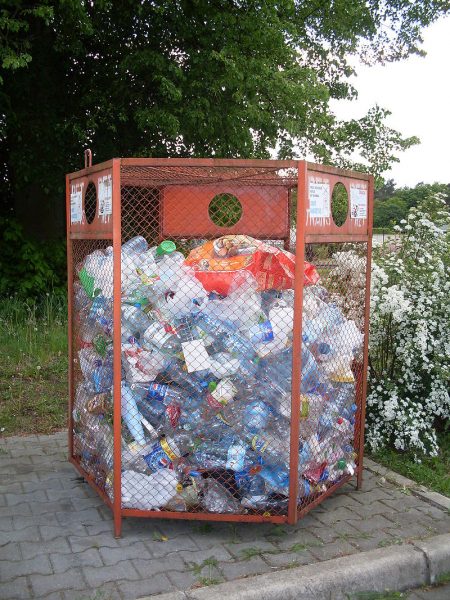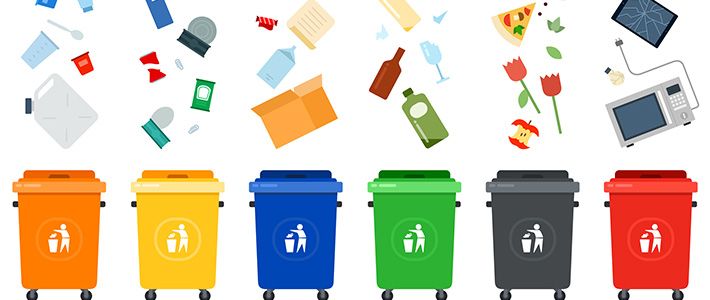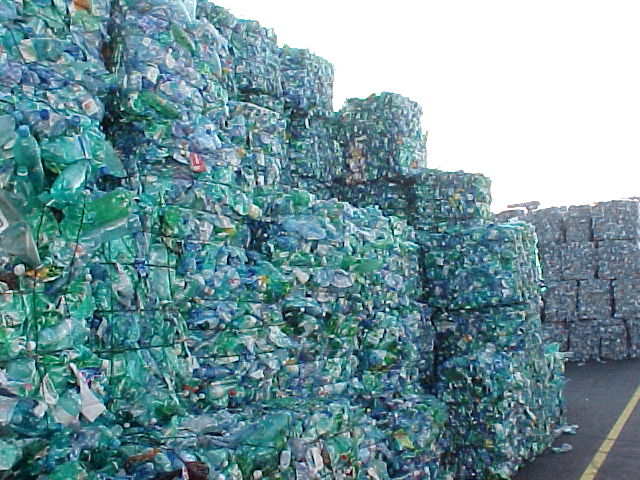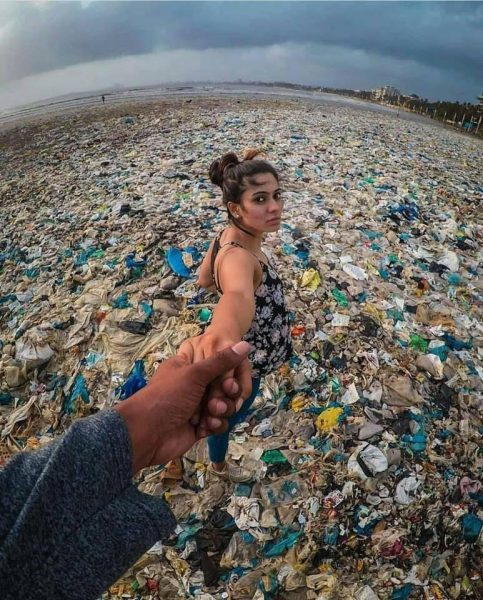
The Plastic Plague, Part 3
“When you think of recycling, you probably think of a magical process where you throw your plastic in the blue bin, and a unicorn takes it away, and nine months later you get a beautiful baby water bottle.” — The Daily Show’s Trevor Noah.
Is there a radical misconception about the ease and efficacy of recycling? Do we think that all of our plastic waste — from used Saran Wrap to the takeout “clamshell” container that delivered your burrito — automatically gets turned into new plastic products?

As was reported by the New York Times back in March, the geoeconomic landscape of recycling is changing, as some developing countries that used to buy plastic from the rest of the world are now getting out of the business. The overall effect this has had on recycling in the United States varies widely between municipalities. Some plastic — especially in Middle America, which does not have access to ports and therefore overseas recycling markets — is going straight into landfills. Some plastic is still getting shipped overseas, being sorted for recyclables, and then going into other countries’ landfills. And even here on the coast, where we have some of the best recycling plants in the world, certain types of plastic that we throw into the bin will still meet their end in a landfill.
As we ask some existential questions about recycling, we want to make it clear that we believe and participate in the practice. But we think the best way to recycle that plastic bottle . . . is to never buy it in the first place.
The Unexpected Whats and How-tos of Recycling
“More than 90% of plastic ever manufactured has not been recycled,” — Spokesperson for a major Bay Area recycling facility
Pop quiz: How much plastic in your average bin do you think gets recycled? We’re willing to bet that it’s less than you think.
“We’re educating people to stick to shapes,” said Kimberly Scheibly, the director of compliance and customer relations at Marin Sanitary Service, or MSS. “Bottles and jugs are reliably recyclable. But they should be emptied and liquid should not be in there. All other plastic is really landfill.” Scheibly also said that the arrows on plastic were a bit of a misnomer. “The arrow doesn’t mean it’s recyclable,” she said. Rather, it’s the item’s resin identification code, which indicates the type of plastic. MSS has an online tool called Where Does it Go Joe?, where users can see where to dispose of various items. We found that a surprising amount of plastic is destined for the landfill. (A recent article in The New Yorker said that, “. . . If recycling were done correctly there would be nine bins for different kinds of plastic, as in Helsinki, or upward of twelve, as is the case in Tokyo.”)

It’s also important — indeed, critical — that recyclables be cleaned before going in the bin. “If people recycle improperly, it can contaminate the entire lot,” said Scheibly, “The only way these materials are valuable to anybody is if they are clean and sorted properly; plastics shouldn’t have food residue on them. We’ve all gotten very used to being able to recycle whatever plastic we have without even thinking about it.”
In a recent story about recycling on The Daily Show, a reporter asked someone at a recycling plant, “‘Is it better for people to recycle wrong, or not at all?’ ‘It’s better for people not to recycle at all,'” the plant worker answered. (Scheibly said she agreed with that sentiment.) One of the most common cases of “improper recycling” concerns the ubiquitous plastic bottle — the reviled poster child for single-use plastics. The Daily Show said the proper method was to remove the hard-plastic cap from the bottle and to cut the hard-plastic band from around the neck before dropping the bottle into the bin.
But . . . wait. “We are now educating people to leave the cap on,” Scheibly said. “But for years, we told people to take the caps off. The technology for processing the bottle has changed.” It’s important, if not obvious, to note that every municipality’s recycling plant can and likely does differ in its processes — and that those processes are constantly evolving. What’s key is to research your local service’s instructions, most of which are available on websites.
We will reiterate here that it’s best to avoid this process all together. A spokesperson for a major Bay Area recycling service said the most effective tool in combating plastic pollution is to “vote with our consumer dollars. Avoid, decline and refuse plastic.” This same spokesperson disagreed with the idea of separating the plastic on water bottles, and said it was best to throw everything into the bin. But this might reflect a different and superior sorting technology. “Recycling is a worthwhile activity if it keeps materials out of landfills,” the spokesperson said.
But they also admitted, “We cannot recycle ourselves out of the problem.”

Let’s take a moment to consider the absurd life cycle of a piece of plastic, and the reincarnation offered through recycling. You drink a small bottle of water in about four minutes. Diligent steward of the environment that you are, you make sure it’s clean, and throw it into a blue bin (you might have even looked up on your phone what to do with the cap). That bottle goes to a recycling plant, is sorted by type, and then put into a “bale.” Those bales are then put on a ship and sent across the ocean (though, as we mentioned, the overseas processors buying our plastic are dwindling). The bales are converted into plastic feed stock, which is then presumably shipped elsewhere to make a product. That product is then shipped back to your local store as a water bottle, where it’s consumed in four minutes, goes back into the bin, and crosses the ocean multiple times. Enormous amounts of energy are used at every single step of this bottle’s lifecycle.
Is Plastic Pollution a Regional Problem?
After posting this photo on our Facebook page — and through the course of our discussion about the plastic plague — some of our readers are quick to point out that plastic pollution is far more endemic to other countries.

“How about mentioning the fact that the US is not the primary problem, nor even two or three?” said one Facebook commenter.
It is absolutely true that member states of the Association of Southeast Asian Nations, or ASEAN, are among the world’s biggest sources of plastic pollution. “More than half of the plastic waste in the ocean comes from just five Asian countries: China, Indonesia, the Philippines, Vietnam and Thailand, according to a 2017 report by the Ocean Conservancy and the McKinsey Center for Business and Environment,” the World Economic Forum reported.
There is also an undeniably different ethos about trash disposal in the developing world. We have watched with quiet, mild horror as people in Southeast Asia chucked their plastic bottles straight into the water. But keep in mind that just a few decades ago, Americans had a similar attitude. There’s a scene from the TV show Mad Men —a show set in the ’60s that depicted a range of anachronisms — where, following a picnic in a lovely park, the Draper family causally shakes the trash off their blanket and drives away. It’s not that Americans were bad people in the ’60s; we just didn’t know any better. We certainly hope that people in the rest of the world will come up to speed on littering as soon as possible.
We’re also willing to bet that if you walk outside today, you’re likely to see a piece of plastic somewhere on the ground, no matter where you live. We see — and pick up and recycle — a little trash on the street nearly every day here in wealthy, environmentally advanced, super-woke Marin County.
And, again, let’s keep in mind that we produce so much trash that we actually export it to other countries, and have created entire economies around our garbage. The Daily Show piece interviewed an Indonesian man who said that his village was very poor before trash from Western countries was brought there to be recycled. “With this trash, I can put my three children through school,” the man said. “My oldest is getting a PhD.”
Our point is that we think it’s counterproductive to think of plastic pollution as “someone else’s problem.” All of humanity is responsible for causing this plague, and all of humanity must be involved in finding the solution.
